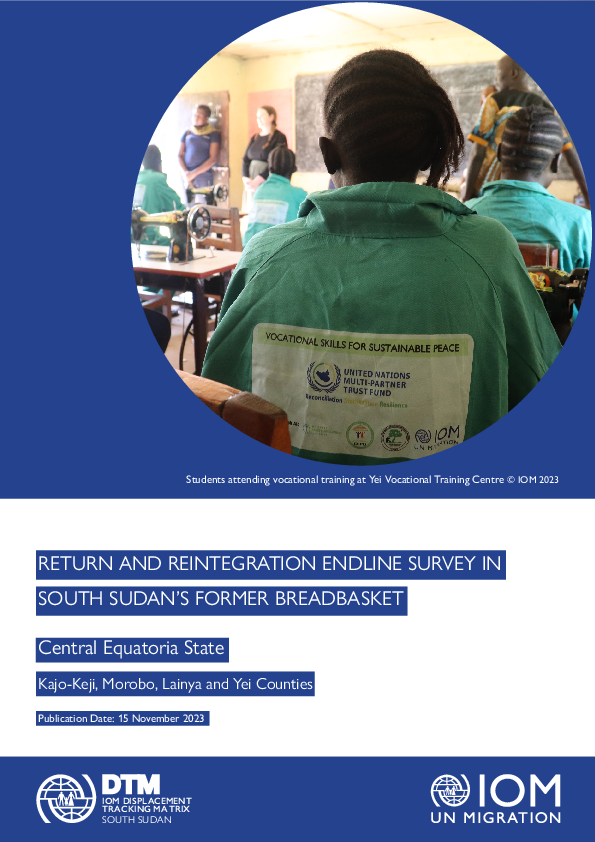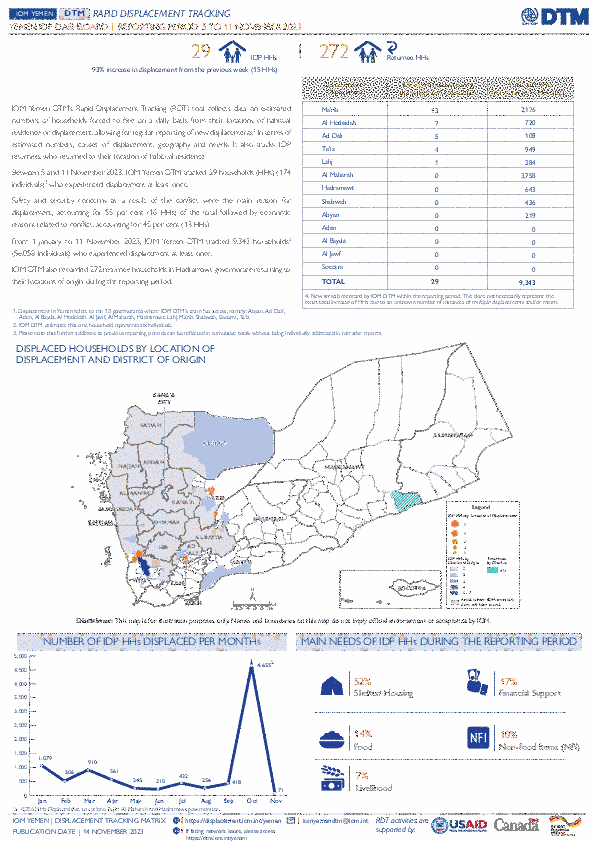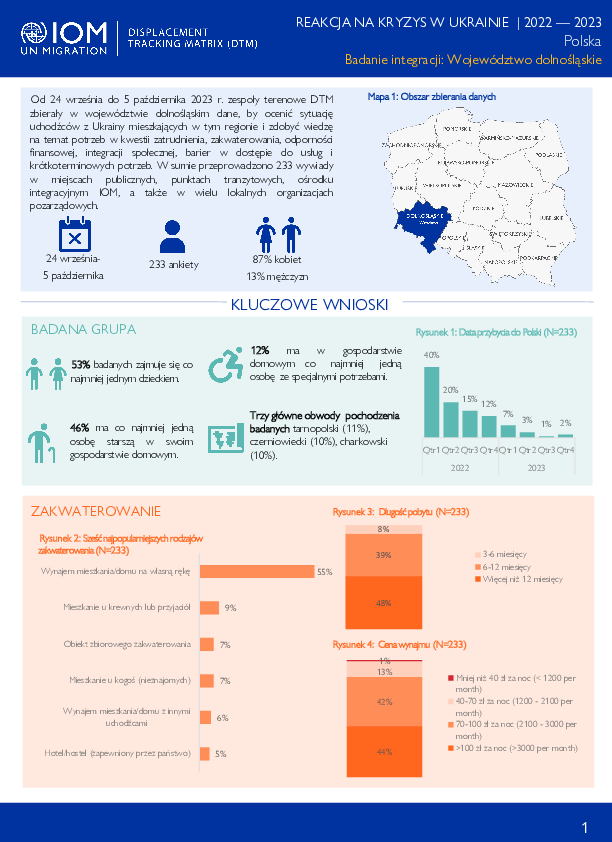-
Countries
-
Data and Analysis
-
Special Focus
-
Crisis Responses

Contact
dtmburundi@iom.int
Language
English
Location
South Sudan
Period Covered
Aug 11 2023
Aug 28 2023
Activity
- Survey
- Return Intention
To gain comprehensive insights into the dimensions of return and reintegration, the International Organization for Migration’s (IOM) Displacement Tracking Matrix (DTM) unit executed a targeted study within Southern Central Equatoria State, as part of the Reconciliation, Stabilization, and Resilience Trust Fund (RSRTF) project in August 2023. This phase of the study involves a meticulous difference analysis between the baseline and endline, designed to illuminate the shifts in the region’s circumstances and provide clarity regarding its current trajectory. By drawing comparisons between these surveys, the intention is to furnish stakeholders with actionable insights that can inform future humanitarian and developmental strategies, ensuring their relevance and effectiveness.
The findings obtained through the survey serve the purpose of establishing an endline and pinpointing the gaps and barriers that impact reintegration and stabilization efforts in Southern Central Equatoria State. This report presents a comprehensive analysis based on data that is representative of the county level. It is crucial to interpret the findings with an understanding of this scope. While the collected data provides valuable insights into the conditions and trends within the counties, its representation of smaller, sub-county divisions is more indicative in nature. In essence, while the report captures broader county-level trends, it may not precisely detail every nuance or variation present at sub-county levels.
Return and Reintegration Index
The Return and Reintegration Index combines data (the numerical version of the data) from eight indicators (8 key areas: housing, livelihoods, WASH, health, education, social cohesion, community stability, and protection) into a single number that provides an indication of the favourability of conditions (Stability Index) to the return and reintegration of displaced people. The calculation of the index was done at the household level.
The index score ranges from 0 to 10 where the higher the index the more favourable the conditions are for the return and reintegration of IDPs and refugees.
The calculation of the index was done at the household level and the results were aggregated at all administrative levels and by population type.
The average (mean) index score is 5.56 out of 10 with both the mean and median values indicating that the central tendency of the data is between 5 and 6.
Kajo-Keji and Morobo emerge as the two best-performing counties, as determined by the average (mean) index scores. While ‘Returnees’ and ‘IDPs’ report the highest mean index scores at 5.79 and 5.72 respectively, it’s important to note that the deviation among the different population groups is minimal, with all scores ranging between 5.3 and 5.7. This indicates a relatively uniform experience across the board, suggesting that while some groups are slightly better off, no single group is significantly outperforming or lagging the others in terms of the index score. Returnees and IDPs appear to experience relatively favorable conditions for return and reintegration compared to those who have been relocated.
Contact
DTM Yemen, iomyemendtm@iom.int
Location
Yemen
Activity
- Mobility Tracking
Period Covered
Nov 05 2023 -Nov 11 2023
From 1 January to 11 November 2023, IOM Yemen DTM tracked 9,343 households (HH) (56,058 Individuals) who experienced displacement at least once.
Between 5 and 11 November 2023, IOM Yemen DTM tracked 29 households (174 individuals) displaced at least once. The majority of people moved into/within the following governorates and districts:
- Ma’rib (13 HHs) – Ma’rib (9 HHs), Ma’rib City (2 HHs), Harib (2 HHs) districts. Most displacements in the governorate originated from Ma’rib and Shabwah.
- Al Hodeidah (7 HHs) – Hays (5 HHs), Al Khukhah (2 HHs) districts. Most displacements in the governorate originated from Al Hodeidah and Ta’iz.
- Ad Dali (5 HHs) – Ad Dali (3 HHs), Al Hasayn (2 HHs) districts. Most displacements in the governorate originated from Al Hodeidah and Ad Dali.
- Ta’iz (9 HHs) – Maqbanah (7 HHs), As Silw (1 HH), Al Mawasit (1 HH) districts.
- Al Hodeidah (6 HHs) – Zabid (2 HHs), Hays (2 HHs), Al Jarrahi (1 HH) districts.
- Ma’rib (3 HHs) – Al Jubah (2 HHs), Harib (1 HH) districts.
Population Groups
IDPs
Relocatees (previously internally displaced)
Returnee (Previously Displaced Abroad)
Survey Methodology
Unit of Analysis Or Observation
Admin Area 4
Site
Site or Location
Type of Survey or Assessment
Household
Key Informant
Keywords
Geographical Scope Partial Coverage
Administrative boundaries with available data
The current dataset covers the following administrative boundaries

Contact
DTM Yemen, iomyemendtm@iom.int
Language
English
Location
Yemen
Period Covered
Nov 05 2023
Nov 11 2023
Activity
- Rapid Emergency Registration
- Mobility Tracking
IOM Yemen DTM’s Rapid Displacement Tracking (RDT) tool collects data on estimated numbers of households forced to flee on a daily basis from their locations of origin or displacement, allowing for regular reporting of new displacements in terms of estimated numbers, geography, and needs. It also tracks returnees who returned to their location of origin.
From 1 January to 11 November 2023, IOM Yemen DTM tracked 9,343 households (HH) (56,058 Individuals) who experienced displacement at least once.
Between 5 and 11 November 2023, IOM Yemen DTM tracked 29 households (174 individuals) displaced at least once. The majority of people moved into/within the following governorates and districts:
- Ma’rib (13 HHs) – Ma’rib (9 HHs), Ma’rib City (2 HHs), Harib (2 HHs) districts. Most displacements in the governorate originated from Ma’rib and Shabwah.
- Al Hodeidah (7 HHs) – Hays (5 HHs), Al Khukhah (2 HHs) districts. Most displacements in the governorate originated from Al Hodeidah and Ta’iz.
- Ad Dali (5 HHs) – Ad Dali (3 HHs), Al Hasayn (2 HHs) districts. Most displacements in the governorate originated from Al Hodeidah and Ad Dali.
The majority of people moved from the following governorates and districts:
- Ta’iz (9 HHs) – Maqbanah (7 HHs), As Silw (1 HH), Al Mawasit (1 HH) districts.
- Al Hodeidah (6 HHs) – Zabid (2 HHs), Hays (2 HHs), Al Jarrahi (1 HH) districts.
- Ma’rib (3 HHs) – Al Jubah (2 HHs), Harib (1 HH) districts.

Contact
DTM Yemen, DTMYemen@iom.int
Language
English
Location
Yemen
Period Covered
Jul 01 2023
Sep 30 2023
Activity
- Flow Monitoring Survey
- Flow Monitoring
This dashboard compiles flow monitoring survey (FMS) data collected in Yemen between July and September 2023 and provides an analysis of migrants’ demographic and socio-economic profiles, including education and employment backgrounds, reasons for leaving their country of origin or habitual residence, future travel intentions, protection and challenges faced during the journey. Also included are migrants’ highest level of education achieved and their labour status prior to moving.
The migration routes in the southern part of Yemen are categorized along two main routes: the south-east route towards Shabwah, Hadramawt, and Al Maharah governorates and the north-east route towards Lahj and Ta’iz governorates. Both routes are traditionally travelled by a large number of migrants each year. Through the Flow Monitoring Registry tool, which focuses on total numbers of migrants (as opposed to the more detailed migrant profile established through the FMS).
DTM recorded 15,227 migrants entered Yemen through the south in the third quarter of 2023. This figure represents a significant decrease compared to the previous quarter, with nearly two thirds (62%) of all migrants were recorded in July. The remainder was recorded in August and September. The significant decrease observed since August is likely attributed to the ongoing joint military campaign initiated to combat smuggling and secure the coastline of Lahj, a well-known governorate for receiving the largest proportion of migrants. The campaign involved deploying troops, conducting raids, and establishing checkpoints.
During the third quarter of 2023, a total of 2,705 surveys were conducted. In Aden (667), Lahj (655), Ma’rib (487), Shabwah (409), Hadramawt (245) and Al Maharah (242). The overall number of surveys increased by one per cent over the previous quarter. The majority of respondents were young male adults between the age of 17 and 25 (78%) searching for economic opportunities (95%), most of whom were single (92%), attained primary education or less (60%), were currently unemployed (94%) and departed from rural areas (78%).

Contact
DTM Europe, DTMMediterranean@iom.int
Language
English
Location
Romania
Period Covered
Jul 01 2023
Sep 30 2023
Activity
- Survey
This report analysed data from a survey carried out between July and September 2023 (Quarter 3, Q3). The survey sample included 1,601 individuals who were crossing back to Ukraine, including 1,589 Ukrainian nationals and 12 Third-Country Nationals (TCNs). The analysis focuses on Ukrainian nationals.
- Top 3 countries of stay abroad: Romania (53%), Bulgaria (19%), Italy (5%).
- Top 3 oblasts of origin: Odeska (38%), Chernivetska (16%), Kyiv city (9%).
- Transport to Ukraine: car (68%), bus (14%), walking (10%), minibus (8%).
- Top areas of assistance received*: food (27%), sanitary supplies (19%), accommodation (18%), and financial support (17%).
- Top 3 needs upon crossing back*: financial support (26%), personal safety (19%), and food supply (17%).

Contact
DTM Poland, IOMDTMPoland@iom.int
Language
Ukrainian
Location
Poland
Period Covered
Sep 24 2023
Oct 05 2023
Activity
- Survey
- Return Intention
З 24 вересня по 5 жовтня 2023 року польові команди DTM збирали дані в регіоні Нижня Сілезія, щоб оцінити ситуацію українських біженців, які проживають у регіоні, та отримати інформацію про потреби в працевлаштуванні, житлі, фінансовій стійкості, соціальній інтеграції, бар'єри в доступі до послуг та короткострокові потреби. Загалом було проведено 233 інтерв'ю в громадських місцях, транзитних пунктах, інтеграційному центрі МОМ, а також з низкою місцевих НУО.

Contact
DTM Poland, IOMDTMPoland@iom.int
Language
English
Location
Poland
Period Covered
Sep 24 2023
Oct 05 2023
Activity
- Survey
- Return Intention
Od 24 września do 5 października 2023 r. zespoły terenowe DTM zbierały w województwie dolnośląskim dane, by ocenić sytuację uchodźców z Ukrainy mieszkających w tym regionie i zdobyć wiedzę na temat potrzeb w kwestii zatrudnienia, zakwaterowania, odporności finansowej, integracji społecznej, barier w dostępie do usług i krótkoterminowych potrzeb. W sumie przeprowadzono 233 wywiady w miejscach publicznych, punktach tranzytowych, ośrodku integracyjnym IOM, a także w wielu lokalnych organizacjach pozarządowych.

Contact
DTM Poland, IOMDTMPoland@iom.int
Language
English
Location
Poland
Period Covered
Sep 24 2023
Oct 05 2023
Activity
- Survey
- Return Intention
From September 24th to October 5th, 2023, DTM field teams conducted data collection in Dolnoslaskie voivodeship to assess the situation of Ukrainian refugees living there and gain an understanding of the employment and housing needs, financial resilience, social cohesion, barriers to accessing services and short-term needs of refugees. In total 233 surveys were conducted in public spaces, transit points, the IOM integration center, as well as at a number of local NGOs.